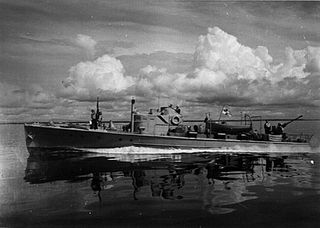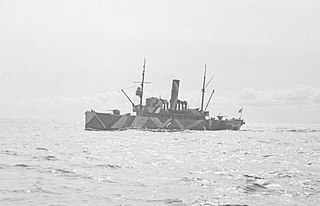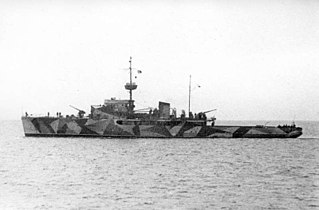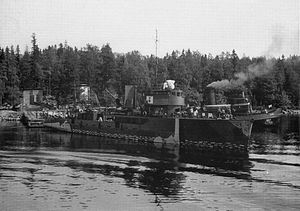
The Finnish Navy is one of the branches of the Finnish Defence Forces. The navy employs 2,300 people and about 4,300 conscripts are trained each year. Finnish Navy vessels are given the ship prefix "FNS", short for "Finnish Navy ship", but this is not used in Finnish language contexts. The Finnish Navy also includes coastal forces and coastal artillery.

Ilmarinen was a Finnish Navy Panssarilaiva. The unit was constructed at the Crichton-Vulcan shipyard in Turku, Finland, and named after the mythological hero Ilmarinen from the Finnish national epic, the Kalevala. Ilmarinen was the flagship of the Navy from 1 May 1933 until her sinking on 13 September 1941.

The Baltic Sea Campaigns were conducted by Axis and Allied naval forces in the Baltic Sea, its coastal regions, and the Gulf of Finland during World War II. After early fighting between Polish and German forces, the main combatants were Germany and Finland, opposed by the Soviet Union. Sweden's navy and merchant fleet played important roles, and the British Royal Navy planned Operation Catherine for the control of the Baltic Sea and its exit choke point into the North Sea.

The minelayer HNoMS Olav Tryggvason was built by the naval shipyard at Horten in the early 1930s and had build number 119. She served in the Royal Norwegian Navy until captured by the Germans in 1940. The Germans renamed her first Albatros II, and a few days later Brummer. She was wrecked in a British bombing raid in northern Germany in April 1945.
Destroyer minesweeper was a designation given by the United States Navy to a series of destroyers that were converted into high-speed ocean-going minesweepers for service during World War II. The hull classification symbol for this type of ship was "DMS." Forty-two ships were so converted, beginning with USS Dorsey (DD-117), converted to DMS-1 in late 1940, and ending with USS Earle (DD-635), converted to DMS-42 in mid-1945. The type is now obsolete, its function having been taken over by purpose-built ships, designated as "minesweeper (high-speed)" with the hull classification symbol MMD.

Turunmaa was a Finnish gunboat built in 1918. She served in the Finnish Navy during World War II. The ship was named after Turuma, a type of frigate designed for use in shallow waters of the archipelago and served in the Swedish Archipelago fleet in the late 18th century. The frigates had in turn been named after the region of Finland.

Karjala (ex-Filin) was a Finnish gunboat, built in 1918 at Ab Crichton shipyard in Turku. She served in the Finnish Navy during World War II. Karjala was named after the Finnic cultural region of Karelia. Like her sister ship Turunmaa, she served as cadet training vessel during peacetime and was nicknamed as Kurjala by cadets.

VMV-class patrol boat was a series of Finnish patrol boats, which served with the Finnish Coast Guard and the Finnish Navy during World War II.

The Taisto class motor torpedo boats or T class was a Finnish-designed class of motor torpedo boats, which saw service with the Finnish Navy during World War II.
Vorpostenboot, also referred to as VP-Boats, flakships or outpost boats, were German patrol boats which served during both World Wars. They were used around coastal areas and in coastal operations, and were tasked with – among other things – coastal patrol, ship escort, and naval combat.

The Soviet evacuation of Tallinn, also called Juminda mine battle, Tallinn disaster or Russian Dunkirk, was a Soviet operation to evacuate the 190 ships of the Baltic Fleet, units of the Red Army, and pro-Soviet civilians from the fleet's encircled main base of Tallinn in Soviet-occupied Estonia during August 1941. Near Juminda peninsula Soviet fleet ran into minefield that had been laid by Finnish and German navies, and were repeatedly attacked by aircraft and torpedo boats, suffering massive losses.
German submarine U-745 was a Type VIIC U-boat built for Nazi Germany's Kriegsmarine for service during World War II, and which was lost at sea on 31 January 1945.

Ruotsinsalmi was a minelayer of the Finnish Navy and the namesake of her class. Ruotsinsalmi was commissioned in 1940 and remained in service until 1975. The vessel was named after the battle of Ruotsinsalmi, which was fought between Sweden and Russia in 1790.

The Ruotsinsalmi-class minelayers were a two-strong class of minelayers in the Finnish Navy.
The Uragan-class guard ships were built for the Soviet Navy as small patrol and escort ships. Eighteen were built in the 1930s and served during World War II in all four of the Soviet Fleets: Baltic, Black Sea, Northern and Pacific. Four were lost during the war and the rest remained in service until the late 1950s in various secondary roles. The official Soviet designation was Project 2, Project 4 and Project 39, but they were nicknamed the "Bad Weather Flotilla" by Soviet sailors by virtue of their meteorological names.

Louhi was a Finnish Navy minelayer. The ship was originally constructed for the Imperial Russian Navy but was taken over by the Finns during the Russian Civil War. She had originally been named Voin, but was renamed as M1 in Finnish service. In 1936 she was given the more personal name Louhi, following the procedure of all other major ships in the Finnish navy.

NMS Amiral Murgescu was a minelayer and convoy escort of the Romanian Navy, the first sea-going warship built in Romania and the largest Romanian-built warship of World War II. She laid numerous minefields, from the Bulgarian port of Burgas to the Crimean port of Sevastopol, which inflicted significant losses to the Soviet Black Sea Fleet. She also carried out numerous convoy escort missions and took part in the Axis evacuation of the Crimea in May 1944. Due to her success in combat, she was decorated twice by May 1944. She was captured by the Soviet Union in September 1944 and served until 1988, when she was scrapped.

The Soviet Navy launched the Soviet submarine Baltic Sea campaign in 1942 to harass the strategic iron-ore traffic from neutral Sweden to Nazi Germany during World War II. The Soviet Union and the German Reich fought each other on the Eastern Front (1941-1945) during the war. The Allies also launched other operations - especially involving the Royal Navy - against the traffic.

The Gulf of Finland U-boat campaign lasted in the Gulf of Finland during the World War II against the Soviet Union between summer 1944 and spring 1945. During the campaign Finland switched sides and joined the Allies.

The Soviet submarine Baltic Sea campaign in 1943 was launched by the Soviet Navy to harass the strategic iron ore traffic from neutral Sweden to Nazi Germany on the Eastern Front during the WWII. Other operations were launched by Allies, especially by the Royal Navy. The offensive was a repetition of the previous campaign in 1942 but resulted in a failed outcome.














